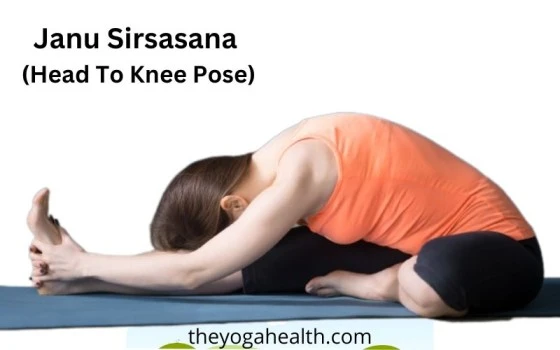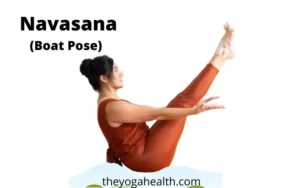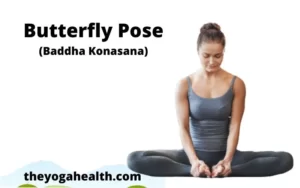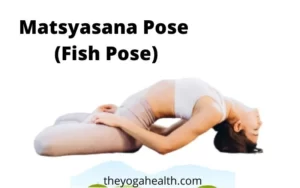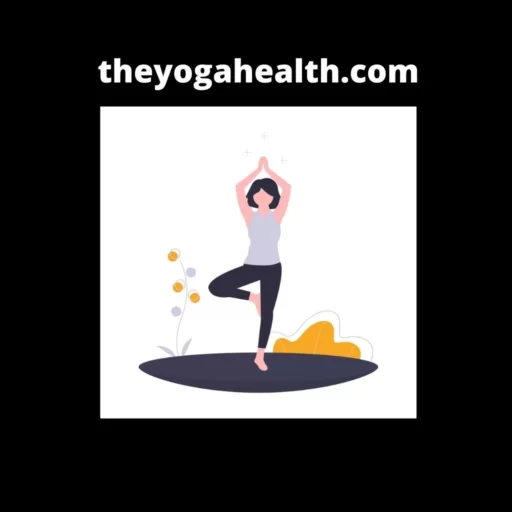Janu Sirsasana (Head to knee pose) is the basic pose of ‘Hatha yoga, it helps to improve energy circulation in the body and is usually included in the flow yoga sequences. It stretches the spine, spleen, liver, groins, shoulders and hamstrings. Regular practice of this pose will increase flexibility of the hamstrings. Janu Sirsasana also stimulates Solar Plexus (Manipura Chakra) and Root Chakra (Muladhara Chakra).
Table of Contents
Janu Sirsasana (Head To Knee Pose)
‘Janu Sirsasana’ comes from the Sanskrit Language, where ‘Janu’ means ‘Knee’, ‘Sirs’ means ‘head’ and ‘asana’ means the ‘pose’ or ‘posture’. In this pose, the head is brought closer to the knee in the sitting position on the floor where one leg is extended on the floor and another leg is bent.
Basic details:
| Sanskrit name | Janu Sirsasana |
| English name | Head to knee pose Head to knee forward bend Seated head to knee pose |
| Difficulty level | Intermediate |
| Position | Sitting on the floor |
Benefits the following muscle groups:
- Hamstring muscles
- Hip muscles
- Lower Back muscles
- Neck muscles
- Groin muscles
- Shoulders
You May Also Like: Paschimottanasana (Seated Forward bend Pose)
Janu sirsasana Benefits
1. Digestion process
In this asana the stomach is pressed on the thighs and forehead on the knees, this action puts pressure on the stomach, which stimulates the stomach organs and helps in the digestion of the food. It also gives relief in cases of all gastric-related issues in the body.
2. Stimulate organs of the body
When this asana is performed it puts pressure on various parts of the body, which helps in stimulating various organs of the body like kidneys, liver, spine, pancreas, uterus, spleen, etc.
3. Strengthening and stretching muscles
This asana stretches the muscles of the abdomen, shoulders, spine, neck, hamstrings, and groins. The stretching of these muscles makes them flexible and stronger.
4. Flexible spine
The regular practice of this asana makes the spine very flexible which helps in curing various other ailments of the body. The forward bend in this pose stretches and strengthens lower back muscles thus makes the entire spine flexible. A flexible spine is also a must for performing various other yoga poses.
5. Obesity control
This asana helps in controlling obesity in the body. Those people having excess weight around their belly immensely benefits when they practice this asana because it particularly works on fat around the belly.
6. Menstruation pain relief
The regular practice of this asana is very helpful during the menstruation cycle. Those women who face problems of excess bleeding and pain during the menstruation cycle will benefit from this asana. Although this asana is not advised during the menstruation period if this asana is performed few days before menstruation starts, it will surely help in easing the symptoms.
7. Beneficial for sportsmen
This asana particularly works on hamstring and hips muscles it will immensely benefit those sportsmen who need a lot of running. This asana is a must for all runners; they should daily practice this asana to get the maximum benefit out of their game.
8. Improves the functioning of the lungs
Janu Shirsasana (Head to knee pose) particularly works on the chest and the lungs by giving them the strength to withstand any climate change. The stimulation improves the functioning of the lungs and cures cold and cough-related ailments.
9. Helpful in slip disk problem
Janu Shirsasana (Head to knee pose) helps in ailments like slip-disk and pains in the lower back muscles. The regular practice of this asana brings fresh blood to the lower back area and helps in relieving pain in that area.
10. Chest and rib bones strengthening
This asana puts a lot of pressure on the chest thereby stimulates and strengthen the chest and rib bones.
11. Anxiety and stress
This asana calms the nerves thereby relaxing the mind and the body. The regular practice of this asana brings down the anxiety and stress levels of the person.
12. Rounded and dropping shoulders
This asana is particularly helpful to those persons who are suffering from rounded and dropping shoulders. All defects in the posture-related to shoulders are removed.
Contraindications
Keep in mind the following precautions before starting this asana
- This asana should be avoided if a person is suffering from severe lower back pain. When you perform this asana you will notice that one side of back muscles is stiffer than the other and doing with asana in such a situation can aggravate the lower back pain, so avoid this asana in such a situation.
- If the person has undergone any stomach-related surgery or operation then this asana should be avoided for at least 6 months after the operation or as long as the medical specialist prohibits it.
- In case of any injury of the knee, this asana should be avoided because in this asana the maximum pressure comes on the knees so in case of any injury on that part further aggravate the situation.
- Pregnant women should also avoid this asana. In this asana a great amount of pressure comes on the stomach and doing asana in such a situation can cause harm to the fetus in the womb.
- If there is an injury on the shoulder or the neck area this asana should be avoided till the injury is healed. It will also be very difficult to perform this asana with injury on the shoulder and neck because shoulders and neck muscles are stretched to maximum levels in this asana which can further cause harm to the injured part.
You May Also like: Headstand (Sirsasana)
Janu Sirsasana steps
- Sit on the yoga mat on the floor and stretch your legs in front of you.
- Now bend your left knee and bring your left foot towards your right inner thigh.
- Make sure that the sole of your left foot is fully touching the right inner thigh and the heel of your left foot is touching the root of the right thigh, at the same time the right leg should be stretched out on the floor.
- Inhale and stretch your arms over your head and shoulders stretching your upper body fully as much as you can.
- Now bend forward keeping your spine and chest straight twisting your hip towards the right side. Make sure that your spine is not rounded in the beginning; try to move forward as far as you can with a straight spine and try to hold your right foot with both hands.
- Once you reach your maximum forward extent with a straight spine then you can round it to touch your chest on your right thigh and your forehead on your right knee.
- Bring both hands forward to hold your right foot tightly interlocking the fingers behind the right sole.
- After completely breathing out, try to put the chest on the right thigh as per your capacity and experience.
- Now place the forehead on the right knee, turning the hip towards the right side. Keeping the tight grip of the right foot, slowly raise and expand your chest and take a deep breath.
- Now using the arms tightly pull the body forward and taking a deep breath again try to move forward. You can stay in this position for about half a minute to a minute. Now again breathe out and again try to move forward. This process can be repeated 5- 6 times as per your capacity.
- Now releasing your hand’s grip on the foot, slowly raise your head, taking a deep breath, stretch your arms out, raising them slowly upward. Now slowly raise the entire upper body and come back to the sitting position.
- Now again bring the hip to the center and release the left leg and stretch it out in front of you, now take few breaths.
- Now slowly bend your right knee and stretch out your left leg in front of you and repeat the same procedure described above with the other leg.
- Now relax and repeat this asana with both legs and try to go deeper every time you practice this asana.
Modifications
If you find this asana difficult to perform in the beginning, then you can also do some modifications in the asana.
You can put a rolled-up blanket under the knee of your extended leg if your hip muscles are tight or your knees are sensitive and you find this asana difficult to perform.
You can also bend your knees a little if your hamstring muscles are stiff and you find it difficult to perform this asana with a straight leg on the floor.
You can also put a strap around the extended foot if this asana is too difficult for you to move forward with a straight spine. You can hold both ends of the strap in each hand while bending forward.
You May Also Like: Shoulderstand (Sarvangasana)
Janu Sirsasana Variations
Use of Strap / Belt
You can use a strap or a belt around the ball of your straight leg foot to extend your reach. Keep your spine straight and do not round your back.
Support for your seated leg stretch
If you feel tightness in your hips or in your lower-back, then you can sit on a folded blanket or a bolster. If your hamstrings are tight and you are facing difficulty, then you can place a rolled up blanket under your knee that is straight. You can also place a folded blanket or a block for support under the thigh of your bent knee if you feel strain or tightness in your knee.
Avoid common mistakes
Avoid these mistakes at the time of performing this asana.
When performing this asana the person should keep his spine straight till he reaches his maximum levels. If the Spine is rounded in the beginning of the asana then it is an incorrect method.
When bending forward aims that your chest touches your thighs other than aiming for touching your knee with your forehead.
Conclusion for Janu Sirsasana:
Janu Sirsasana is very helpful for all regular practitoners of Yoga for its large number of benefits. Those persons suffering from enlargement of the prostate gland should stay in this asana longer. They should also do Sarvangasana and its variations along with this asana for maximum benefit.
This asana stimulates the liver, kidney, and spleen, thereby help in the digestion process. People suffering from a low fever for a long time should also do this asana for complete cure.
FAQs: Janu Sirsasana
Q1. What is janu Sirsasana good for
This asana has several benefits like it stretch and strengthen your spine and stomach muscles.
Regular practice of this asana helps in digestion, obesity, stimulates kidneys, liver, spine, pancreas, lungs, and uterus and also makes spine flexible.
Q2. What muscles are stretched in Janu Sirsasana
This is a full forward bend sitting pose that stretches your ankle to your hips, along with full length of your back.
Q3. How to pronounce Janu Sirsasana
(Jah-new-shear-shahs-anna)
Share your experience of doing this asana and let us know if you have any questions or comments regarding this Pose in the comments section below.


